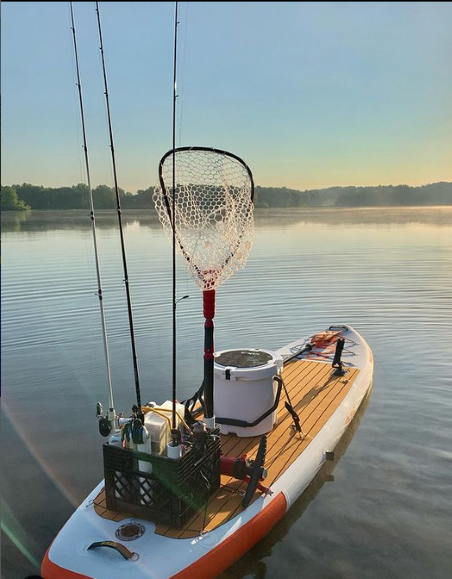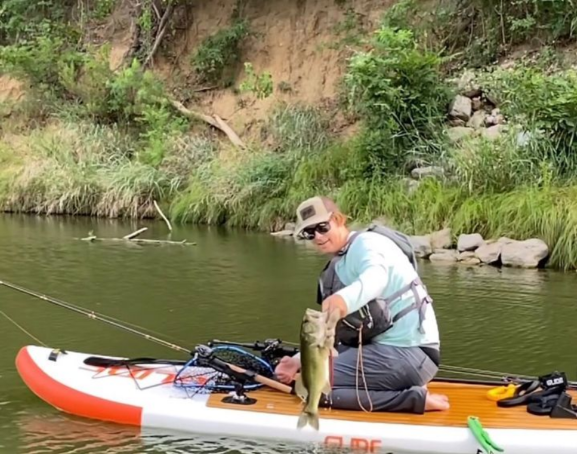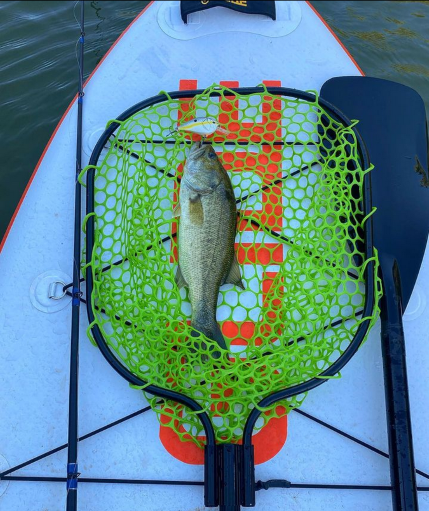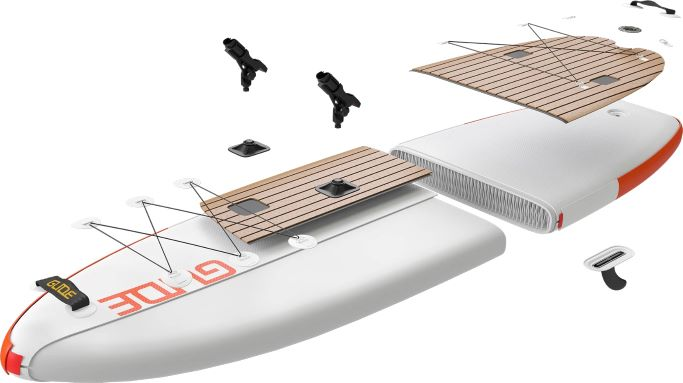
Landing Fish While SUP Fishing: Tips and Techniques.
Key Highlights
- Unrivaled Portability: Inflatable paddle boards redefine convenience, allowing easy transportation and storage, perfect for travelers and those with limited space.
- Exceptional Durability: Constructed with advanced materials, iSUPs withstand bumps and scrapes, ensuring longevity and consistent performance.
- Supreme Versatility: From serene lake paddles to SUP yoga, find an iSUP designed for every activity and skill level.
- Stability and Confidence: Ideal for beginners and experienced paddlers alike, iSUPs offer a stable platform for a safer and more enjoyable experience.
- Cost-Effective Adventure: Offering competitive pricing, iSUPs make paddleboarding accessible to a broader audience without compromising on quality.
- Effortless Setup: Transition from bag to water in minutes with iSUPs, maximizing your time spent enjoying the great outdoors.
- Eco-Friendly Choice: Embrace sustainable water sports with iSUPs, designed to minimize environmental impact.
Fishing while Stand Up Paddleboarding (SUP) is a unique and exciting experience. Not only do you get to enjoy the serenity of the water and beautiful scenery, but you also get to reel in fish. However, landing a fish once it's hooked can be challenging, especially if you're new to SUP fishing. In this article, we'll provide you with tips and techniques on how to land fish while SUP fishing.
Table of Contents.
Understanding Fish Behavior
Gear and Equipment for Landing Fish
Hook Set and Fighting Techniques
Reeling in the Fish
Landing and Handling the Fish
Releasing the Fish
Safety Precautions
SUP Fishing Etiquette
Common Mistakes to Avoid
Conclusion
FAQs
1. Understanding Fish Behavior.

Before we dive into the techniques for landing fish, it's important to understand fish behavior. Different species of fish behave differently, so it's essential to have some knowledge about the type of fish you're targeting. Understanding their behavior will help you anticipate their movements and adjust your tactics accordingly.
For example, predatory fish such as bass and pike will usually follow your bait before they strike. They'll try to grab the bait and swim away, so it's important to wait a few seconds before setting the hook. On the other hand, fish like trout and salmon are more likely to take your bait immediately, so you need to set the hook right away.
2. Gear and Equipment for Landing Fish.

Having the right gear and equipment is crucial for landing fish successfully. Here are some essential pieces of equipment you'll need:
Fishing rod: Choose a rod that is appropriate for the size of fish you're targeting.
Fishing reel: Match your reel with your rod and line.
Fishing line: Use a strong and durable fishing line.
Bait and lures: Choose baits and lures that are effective for the type of fish you're targeting.
Life jacket: Always wear a life jacket when fishing on a SUP board.
3. Hook Set and Fighting Techniques.

Setting the hook and fighting the fish is the most critical part of landing a fish successfully. Here are some techniques to help you:
Wait for the right moment: As mentioned earlier, different fish species have different behaviors. Wait for the fish to grab your bait properly before setting the hook.
Use the right hook set: A hook set is the technique you use to set the hook into the fish's mouth. Different species of fish require different hook sets. For example, bass and pike require a strong hook set, while trout and salmon require a gentle hook set.
Keep the line tight: Once the fish is hooked, keep the line tight to prevent the fish from escaping.
Let the fish tire itself: Fighting the fish requires patience. Let the fish tire itself out before trying to reel it in.
4. Reeling in the Fish.

Reeling in the fish requires skill and technique. Here are some tips to help you:
Use your whole body: Use your arms, shoulders, and hips to reel in the fish.
Keep the rod tip up: Keeping the rod tip up will help prevent the fish from diving and getting tangled in the weeds.
Reel in the slack: As you reel in the fish, make sure to reel in the slack line.
5. Landing and Handling the Fish.

Once you've reeled in the fish, it's time to land and handle it properly. Here are some tips to help you:
Use a landing net: Using a landing net is the safest way to land a fish while SUP fishing. Make sure the net is big enough to fit the fish you're targeting.
Be gentle: When you lift the fish out of the water, do it gently and avoid touching the gills or eyes.
Remove the hook: Use pliers or a hook remover to remove the hook gently. If the hook is deep inside the fish's mouth, cut the line close to the hook and release the fish.
Take a quick photo: If you want to take a photo, make sure to do it quickly and avoid exposing the fish to the air for too long if you are going to release the fish.
Release the fish: Once you've taken the photo, gently release the fish back into the water. Hold it in the water until it swims away on its own.
6. Releasing the Fish.

Releasing the fish properly is crucial for their survival. Here are some tips to help you:
Revive the fish: After you've released the fish, hold it in the water and move it back and forth gently to help it breathe.
Don't handle the fish too much: Handling the fish too much can damage its scales and slime coating, which can make it vulnerable to disease and parasites.
Use barbless hooks: Barbless hooks are easier to remove and cause less damage to the fish's mouth.
Follow local regulations: Some areas have specific regulations for releasing fish, such as minimum size and bag limits. Make sure to follow these regulations to protect the fish population.
7. Safety Precautions.

Fishing on a SUP board can be dangerous if you're not careful. Here are some safety precautions to take:
Wear a life jacket: Always wear a life jacket when fishing on a SUP board.
Check the weather: Check the weather forecast before you head out. Avoid fishing in rough or stormy conditions.
Bring a whistle and signaling device: In case of an emergency, bring a whistle and signaling device to attract attention.
Know your limits: Don't venture too far from shore or into deep water if you're not a confident swimmer.
8. SUP Fishing Etiquette.

Respect for the environment and other fishermen is essential when SUP fishing. Here are some etiquette rules to follow:
Don't disturb other fishermen: Avoid getting too close to other fishermen or disturbing their fishing spots.
Keep noise levels low: Loud noises can scare away fish and other wildlife.
Respect the environment: Don't litter or damage the environment. Take your trash with you and leave the area as you found it.
Follow local regulations: Some areas have specific regulations for SUP fishing, such as no-wake zones and restricted areas. Make sure to follow these regulations to avoid fines and protect the environment.
9. Common Mistakes to Avoid.

Here are some common mistakes that new SUP fishermen make and how to avoid them:
Using the wrong gear: Make sure to choose the right gear and equipment for the type of fish you're targeting.
Not waiting for the right moment: Patience is key when fishing. Wait for the fish to grab your bait properly before setting the hook.
Losing your balance: Practice your balance and technique before heading out into deeper waters.
Fighting the fish too hard: Let the fish tire itself out before trying to reel it in. Fighting the fish too hard can break the line or damage the fish's mouth.
10. FAQs.
Do I need a special type of SUP board for fishing?
While some SUP boards are designed specifically for fishing, you can use any stable and sturdy board for SUP fishing. Make sure to choose a board with enough space to accommodate your gear and equipment. If you are looking for a dedicated fishing paddle board check out the Glide O2 Angler.
What type of bait is best for SUP fishing?
The best bait for SUP fishing depends on the type of fish you're targeting and the fishing location. Research the fish species and their feeding habits in your area and choose the appropriate bait accordingly.
Is it safe to fish on a SUP board?
Fishing on a SUP board can be safe if you follow proper safety precautions such as wearing a life jacket and checking the weather forecast. However, it's important to be aware of the risks and take appropriate measures to ensure your safety.
Can I fish on a SUP board in any type of water?
You can fish on a SUP board in most types of water, including lakes, rivers, and even inshore saltwater or offshore. However, it's important to research the specific water conditions and fish species in your area to ensure your safety and success.
How do I choose the right size and type of fishing rod for SUP fishing?
The right size and type of fishing rod for SUP fishing depend on the type of fish you're targeting and the fishing conditions. Consider the fish species, water depth and current, and your level of experience when choosing a fishing rod.
11. Conclusion.

SUP fishing is an exciting and challenging outdoor activity that combines the benefits of stand-up paddleboarding and fishing. Once you've hooked a fish, the landing process is critical to ensure the fish's survival and to maintain the health of the fish population.
By following the tips and techniques outlined in this article, you can improve your chances of successfully landing fish while SUP fishing. Remember to be patient, use the right equipment, and prioritize the safety of yourself, others, and the environment.
Whether you're an experienced angler or new to fishing, SUP fishing offers a unique and rewarding way to enjoy the great outdoors and connect with nature. So grab your SUP board, fishing gear, and a sense of adventure, and head out to the water for an unforgettable fishing experience.
Glide Paddle Boards SUP Fishing Tips.

Paddle board fishing a comprehensive guide.
The Glide O2 Angler. Fishing sup board perfect for your next fishing adventure. Glide makes the right paddle board for all your paddle boarding adventures.

Glide beginners tips to sup fishing.


